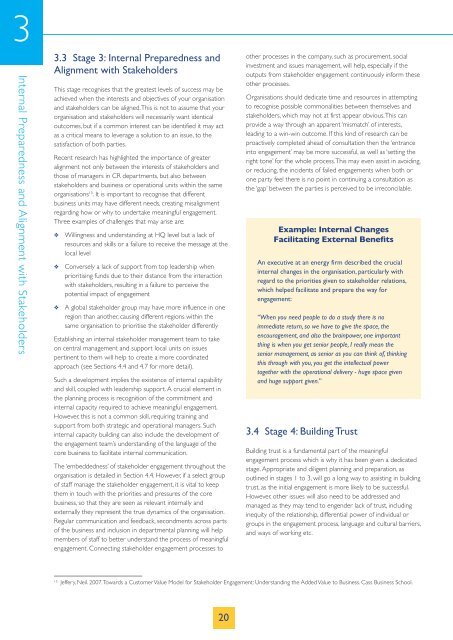Stakeholder Engagement - Cranfield School of Management ...
Stakeholder Engagement - Cranfield School of Management ...
Stakeholder Engagement - Cranfield School of Management ...
You also want an ePaper? Increase the reach of your titles
YUMPU automatically turns print PDFs into web optimized ePapers that Google loves.
3<br />
Internal Preparedness and Alignment with <strong>Stakeholder</strong>s<br />
3.3 Stage 3: Internal Preparedness and<br />
Alignment with <strong>Stakeholder</strong>s<br />
This stage recognises that the greatest levels <strong>of</strong> success may be<br />
achieved when the interests and objectives <strong>of</strong> your organisation<br />
and stakeholders can be aligned.This is not to assume that your<br />
organisation and stakeholders will necessarily want identical<br />
outcomes, but if a common interest can be identified it may act<br />
as a critical means to leverage a solution to an issue, to the<br />
satisfaction <strong>of</strong> both parties.<br />
Recent research has highlighted the importance <strong>of</strong> greater<br />
alignment not only between the interests <strong>of</strong> stakeholders and<br />
those <strong>of</strong> managers in CR departments, but also between<br />
stakeholders and business or operational units within the same<br />
organisations 15 . It is important to recognise that different<br />
business units may have different needs, creating misalignment<br />
regarding how or why to undertake meaningful engagement.<br />
Three examples <strong>of</strong> challenges that may arise are:<br />
❖ Willingness and understanding at HQ level but a lack <strong>of</strong><br />
resources and skills or a failure to receive the message at the<br />
local level<br />
❖ Conversely a lack <strong>of</strong> support from top leadership when<br />
prioritising funds due to their distance from the interaction<br />
with stakeholders, resulting in a failure to perceive the<br />
potential impact <strong>of</strong> engagement<br />
❖ A global stakeholder group may have more influence in one<br />
region than another, causing different regions within the<br />
same organisation to prioritise the stakeholder differently<br />
Establishing an internal stakeholder management team to take<br />
on central management and support local units on issues<br />
pertinent to them will help to create a more coordinated<br />
approach (see Sections 4.4 and 4.7 for more detail).<br />
Such a development implies the existence <strong>of</strong> internal capability<br />
and skill, coupled with leadership support. A crucial element in<br />
the planning process is recognition <strong>of</strong> the commitment and<br />
internal capacity required to achieve meaningful engagement.<br />
However, this is not a common skill, requiring training and<br />
support from both strategic and operational managers. Such<br />
internal capacity building can also include the development <strong>of</strong><br />
the engagement team’s understanding <strong>of</strong> the language <strong>of</strong> the<br />
core business to facilitate internal communication.<br />
The ‘embeddedness’ <strong>of</strong> stakeholder engagement throughout the<br />
organisation is detailed in Section 4.4. However, if a select group<br />
<strong>of</strong> staff manage the stakeholder engagement, it is vital to keep<br />
them in touch with the priorities and pressures <strong>of</strong> the core<br />
business, so that they are seen as relevant internally and<br />
externally they represent the true dynamics <strong>of</strong> the organisation.<br />
Regular communication and feedback, secondments across parts<br />
<strong>of</strong> the business and inclusion in departmental planning will help<br />
members <strong>of</strong> staff to better understand the process <strong>of</strong> meaningful<br />
engagement. Connecting stakeholder engagement processes to<br />
20<br />
other processes in the company, such as procurement, social<br />
investment and issues management, will help, especially if the<br />
outputs from stakeholder engagement continuously inform these<br />
other processes.<br />
Organisations should dedicate time and resources in attempting<br />
to recognise possible commonalities between themselves and<br />
stakeholders, which may not at first appear obvious.This can<br />
provide a way through an apparent ‘mismatch’ <strong>of</strong> interests,<br />
leading to a win-win outcome. If this kind <strong>of</strong> research can be<br />
proactively completed ahead <strong>of</strong> consultation then the ‘entrance<br />
into engagement’ may be more successful, as well as ‘setting the<br />
right tone’ for the whole process.This may even assist in avoiding,<br />
or reducing, the incidents <strong>of</strong> failed engagements when both or<br />
one party feel there is no point in continuing a consultation as<br />
the ‘gap’ between the parties is perceived to be irreconcilable.<br />
Example: Internal Changes<br />
Facilitating External Benefits<br />
An executive at an energy firm described the crucial<br />
internal changes in the organisation, particularly with<br />
regard to the priorities given to stakeholder relations,<br />
which helped facilitate and prepare the way for<br />
engagement:<br />
“When you need people to do a study there is no<br />
immediate return, so we have to give the space, the<br />
encouragement, and also the brainpower, one important<br />
thing is when you get senior people, I really mean the<br />
senior management, as senior as you can think <strong>of</strong>, thinking<br />
this through with you, you get the intellectual power<br />
together with the operational delivery - huge space given<br />
and huge support given.”<br />
3.4 Stage 4: Building Trust<br />
Building trust is a fundamental part <strong>of</strong> the meaningful<br />
engagement process which is why it has been given a dedicated<br />
stage. Appropriate and diligent planning and preparation, as<br />
outlined in stages 1 to 3, will go a long way to assisting in building<br />
trust, as the initial engagement is more likely to be successful.<br />
However, other issues will also need to be addressed and<br />
managed as they may tend to engender lack <strong>of</strong> trust, including<br />
inequity <strong>of</strong> the relationship, differential power <strong>of</strong> individual or<br />
groups in the engagement process, language and cultural barriers,<br />
and ways <strong>of</strong> working etc.<br />
15 Jeffery, Neil. 2007.Towards a Customer Value Model for <strong>Stakeholder</strong> <strong>Engagement</strong>: Understanding the Added Value to Business. Cass Business <strong>School</strong>.
















